Basketball Defense - Man-to-Man Pressure Defense (Part 2)
By Dr. James Gels, From the Coach’s Clipboard Basketball Playbook"Helping coaches coach better..."
Disclosure: This page contains affiliate links, which means that Coach's Clipboard receives a small commission (at no cost to you) if you make a purchase using these links.

First see Man-to-Man Pressure Defense (Part 1) - force sideline, on-ball, deny, helpside, help and recover, dribble-penetration.
Also see Man-to-Man Pressure Defense (Part 3) - defending screens.
This page discusses pressure man-to-man defense and how we defend post players, cutters, out-of-bounds plays and some special trapping actions.
Contents
- Defending post players
- Defending cutters
- Defending Baseline Out-of-Bounds Plays
- "Red" -- Aggressively Trapping the Point Guard
- "Side-Fist" -- Aggressively Trapping the Wing
Man-to-Man Defense - Defending post players.
We try to deny the pass into the low post. When the ball gets in the post, the opponent either scores or we foul. When the ball is on the top (point), our post defenders full-front with both feet above the offensive player, with one hand on, and the other hand up to prevent the lob.As the ball is passed to the wing, the post defender quickly drops under and around (not over) the offensive player, to half front from the baseline side. With our post defender X4 on the baseline side, if O4 actually receives the pass, X4 is in position to deny a drop-step move to the baseline (and will get help from the top X3). Additionally, X4 is in good position to stop baseline dribble-penetration.
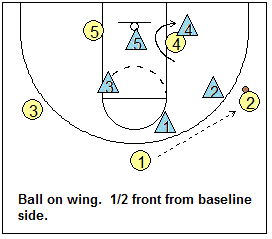

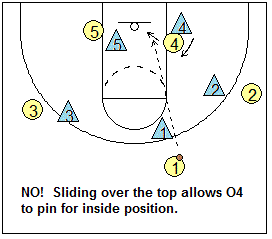
Some coaches completely full-front the low post. We do that only if our post defender is much smaller than the offensive player, such as when the offensive post player is a giant, or after a switch on a screen and we're caught with a smaller guard defending their post player. We defend the post lob by (1) the wing defender on the ball pressures the ball to make the pass difficult; (2) the opposite helpside post defender rotates to defend or tip the pass; (3) our helpside wing defender drops down to cover the back-side post.
If the ball is passed back out to the point, X4 will quickly slide under and around O4 (not over) and again full-front when the ball is at the top. Our post defender slides under (rather than over) the offensive player because if X4 went over, he/she could be sealed outside, and be vulnerable to a quick pass inside. Also, sliding under gives us inside rebounding position. Your post defenders must work hard with good footwork to accomplish this.
We also want to keep the ball out of the high post (elbow or free-throw line area). Here we will 1/2 or 3/4 front the high post. The technique here is for the defender to keep his feet between his man and the basket but have one arm and hand wrapped around in front of the high post player in the passing lane.
Double-teaming a dominant low post player. See the diagrams below. Against a star post player, 1/2 or 3/4 front as usual from the baseline side. If the ball does get into the low post, double-team it with your helpside wing defender (X3). X4 prevents O4's baseline move while X3 stops the move to the lane. X2 denies the pass back out to O2. X1 slides into the gap between O1 and O3 to cover the skip pass.
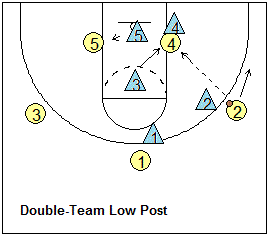

Some teams double-team by having X2 (ball-side wing defender) slide down inside to double-team. We don't like this for two reasons:
(1) Usually X2 is too slow getting there, and has a bad angle in preventing O4's move to the lane.
(2) This leaves O2 wide-open for a quick pass back outside and an open three-point shot.
Defending this way keeps our weakside post defender X5 on O5, (no size mis-match). Notice that this rotation is different from baseline dribble-penetration (where X5 sprints over to the ball, and X3 drops to the backside).
This is preferable to double-teaming with the opposite post player, as that would leave the remaining offensive post player unguarded, or guarded by the smaller X3. Using the opposite wing to double may make you susceptible to the opposite wing kick-out and three-pointer (diagram C). To defend that outside shot, the X1 defender closes-out on the skip pass, and takes the ball. If the pass goes to O3, X1 takes O3, while X3 sprints out to take O1. We call this a defensive "X-cut". X2 moves into helpside.
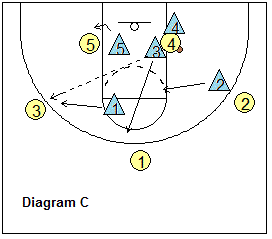
See Trapping the Low Post. Also see below about defending inside, post screens.
Man-to-Man Defense - Defending cutters.
Another important point is to deny the pass to a cutter moving through the lane. Here the defender must try to keep between his man and the ball, denying the pass.One technique the defender can use is to "bump the cutter" off his/her intended pathway by getting position and riding the cutter away from the basket. "Bumping" may not be a good term as it implies "hitting" the cutter, or something with contact. Rather, it means getting inside position on the cutter, or at least an arm in front in the passing lane, much like ½ or ¾ fronting a post player.
The defender tries to beat the cutter to a certain spot on the floor, which really is no different than two players fighting for rebounding position… both are entitled to that spot on the floor, it just depends on who gets there first. So the defender must use good footwork and establish position... you cannot simply push or hold the offensive player.
Examples of cuts to defend against are the "give and go" cut, a cut from the weakside wing (either with or without a screen), flash cuts to either high or low post, back-cuts, etc.
An important point is the concept of "jumping to the ball" (see left diagram below). As the ball moves (either pass or dribble), defenders should "jump to the ball", or move a step or so toward the ball. Not only does this help deny the pass, but also puts the defender in the cutter's path and the defender has a better chance of bumping and denying the cutter. All defenders should learn to react to every movement of the ball.
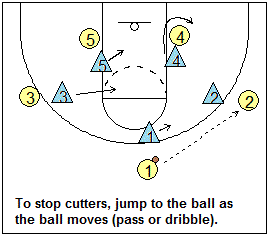
One special circumstance... defending the curl cut. See the diagrams below. A good quick guard will sometimes run down low and curl around a post player in order to lose his man. We believe the best defense here is for the defender to "chase" the offensive player around the screen as closely as possible.
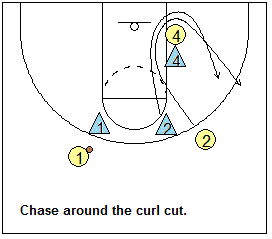

Sometimes I'll see the defender instead just drop back outside thinking the cutter will be coming back out to his original spot or the perimeter. The right-hand diagram below illustrates the error in this thinking. A good offensive player will read this and pop out to the corner instead for the skip pass and open three-pointer.
Man-to-Man Defense - Defending Baseline Out-of-Bounds Plays
Some coaches like to zone the baseline OB play with a 2-3 zone. However, there are plays designed that can beat this defense (see "Out-of-Bounds Plays vs the 2-3 Zone"). Here is a way to play the baseline out-of-bounds situation man-to-man without getting burned inside.First, "step under" and switch any inside screens (see the right diagram below). The screened defender X4 steps under (one step back toward the baseline) to get inside position on the screener O5, in order to avoid getting "pinned".
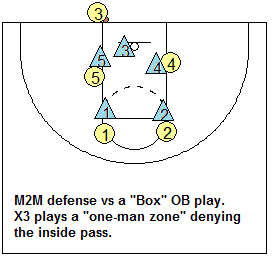
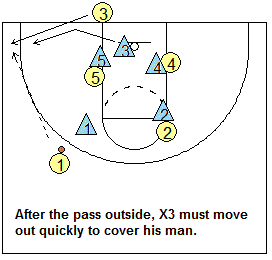
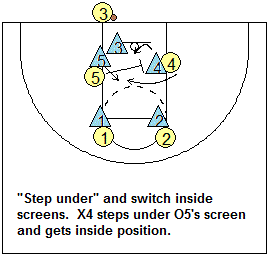
In addition, deny the pass inside by having your inbounds defender play a "one-man zone" in the paint. In the diagram below left, X3 drops off the inbounder into the paint, looking to deny any pass inside and lay-up. But once the pass goes outside, he/she must move quickly back on the inbounder (O3), who may step out to the corner for the outside shot (below right).
Again, the rules for defending baseline inbounds plays are:- Match-up man-to-man.
- X3 plays a "one-man zone" off the inbounder denying the inside pass, but still being wary of the pass back to the inbounder.
- Step-under and switch any inside post screens.
Man-to-Man Defense - "Red" - Aggressively Trapping the Point Guard
On occasion, as a surprise tactic, try an aggressive trap on the point guard. This could occur just after O1 dribbles the ball across half-court, or when the X1 defender cuts and forces O1 to one side.Oftentimes teams do this whenever there is an on-the-ball screen. Both defenders jump out and try to trap the ball. You can call this something like "Red" or "Hot", or call it nothing and just execute it from time to time by allowing the wing defenders, X2 and X3, to read and react to the situation. See the diagrams below.
In diagram A, X1 overplays and forces O1 to the right. The wing defender X2 triggers the defense by aggressively running up and closing out on O1. X2 and X1 trap or force O1 more and more into a corner along the sideline. As soon as X2 goes up, X4 should move out to deny the pass up the sideline and X3 should deny any pass across the middle.
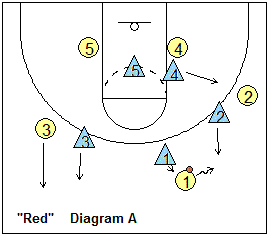


X5 must read the backside offense. X5 half-fronts the high post player, denying that pass while still being able to recover on a long lob pass to O5. Usually this long pass is not readily visible to O1 who is under extreme pressure. Defenders try to get the 5-second call, jump ball, an interception, or simply let the offense turn the ball over with a bad pass or travel.
The "Red" defense is a gamble, but often is very effective if used as a surprise tactic, perhaps after a time-out, or a made free-throw, or as a special call from the bench. It might help you get a steal late in a close game. Getting steals off this can turn into breakaway lay-ups. The keys are: the trapping defensive players must initiate the action and be much more aggressive than the offensive player being trapped (without fouling), and the remaining three defenders must deny or intercept the pass out of the trap.Man-to-Man Defense - "Side-Fist" -- Aggressively Trapping the First Pass to Either Wing
Another surprise tactic, is to trap the first pass from the point guard O1 to either wing (O2 or O3). Often it is not easy to double-team a good point guard in the middle of the floor. So instead, we have X1 pressure O1, with X2 and X3 playing off their man, allowing the pass to the wing. On the first pass to either wing, we will aggressively trap along the sideline. It is easier to trap along the sideline than it is in the middle of the court.In diagram A below, the pass is made to the O2, and X2 and X1 immediately, aggressively trap. X3 quickly rotates over to deny the pass back to O1. X5 will move up toward the free-throw line to deny a pass to either the high post, or a skip pass across to O3. X4 denies the pass to O4.
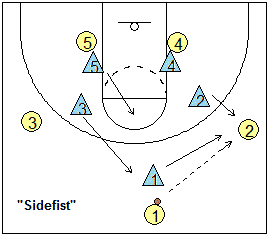

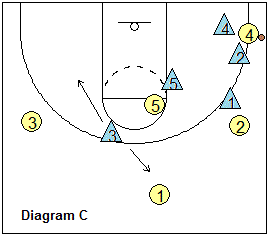
We continue to trap if the ball is passed (or dribbled) into the corner (diagram B). Here, X4 and X2 will trap, while X1 denies the pass back out to O2, and X5 denies the pass to O5 (diagram C). X3 plays half-way between O1 and O3, looking to intercept a long skip pass. X3 and X5 must always be wary of O3 making a back-door basket cut, and must drop inside if that happens.
We give up the long pass back out to O1, but never the back-door basket cut. When trapping, we are going for a 5-second call, a jump ball (although we stress not reaching in and fouling), or try to force a bad pass or turnover. Our trappers make it difficult for the trapped player to make a long pass, by "squeezing the trap" and getting their hands up high when the ball is raised up for a long pass. Sometimes, we can tip this pass.
If the offense successfully passes back into the middle of the court (to O1 or to the high post), "Side-Fist" is immediately terminated, as we do not trap at the point or the high post. We only trap along the sidelines (and baseline). It's usually one or two sideline traps and it's done. We immediately match-up man-to-man and play our usual man-to-man rules.
Use this as a surprise tactic, perhaps after a time-out, or a made free-throw, or with a new O2 or O3 substitution. Also, this can be a late game tactic, when you are behind and need a steal. Like "Red" above, it's a gamble, but as a surprise tactic, with your defenders being the aggressors, you might create some key turnovers.
Are your players lacking in quickness? Then take a look at the "Pack Line Defense".
Related pages:
- Man-to-Man Pressure Defense (Part 1) - force sideline, on-ball, deny, helpside, help and recover, dribble-penetration
- Man-to-Man Pressure Defense (Part 3)- defending screens
- Switching Man-to-Man Defense
- Bob Kloppenburg's SOS Defense
- Teaching Defense and How to Defend Screens by Progression
- Defending the Pick and Roll
- Basic Defense
- Shell Drill
- Man-to-Man Breakdown Drills
- Man-to-Man Positioning Drill
- 1-on-1 Drill
- Defensive Close-Outs and Drills
- Taking The Charge - Tips and Drills